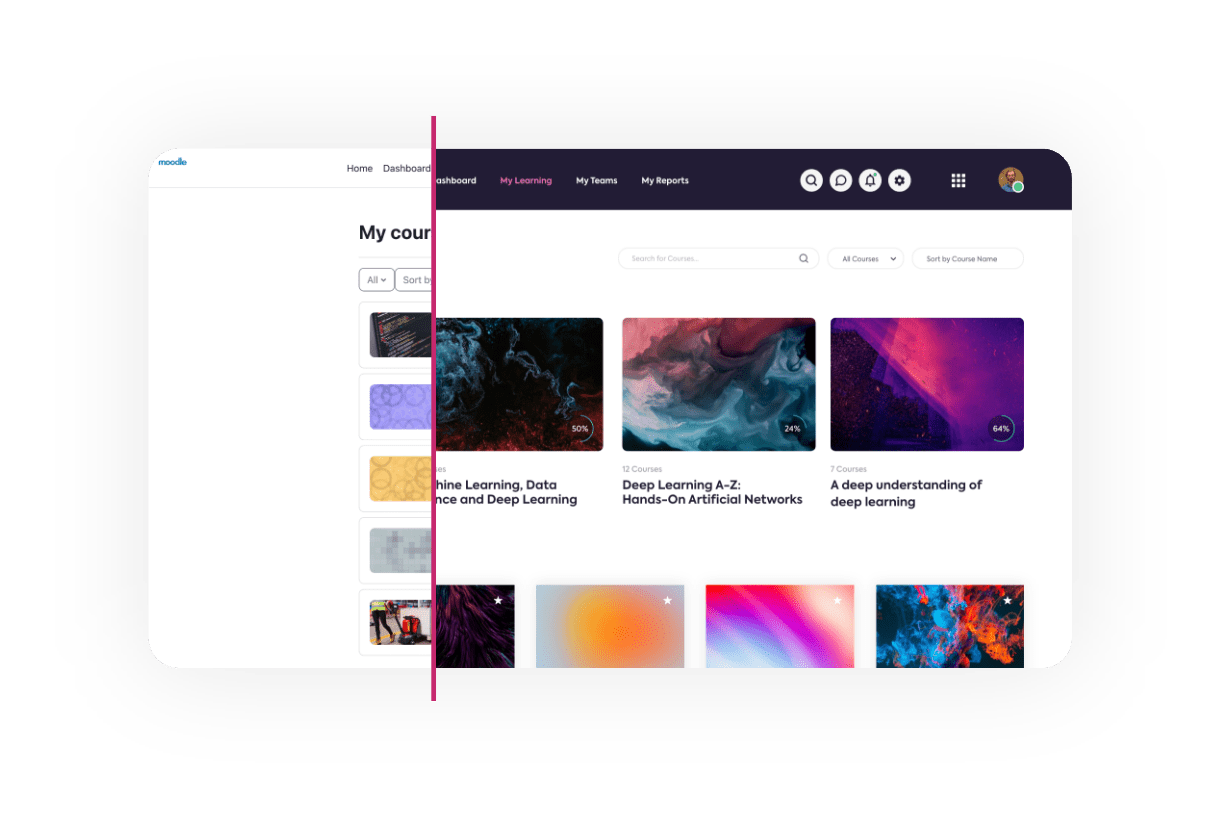Today, customer training is a vital tool in building customer engagement and retention, especially in sectors where technology and services evolve rapidly. As many businesses are discovering, having a well-structured LMS in place can greatly enhance the training experience, offering tailored learning pathways that align with customer needs and business objectives.
In this guide, we’ll take a closer look at the essential components of customer training and how choosing the right LMS can transform routine customer interactions into opportunities for growth, loyalty and increased lifetime value.
What is customer training?
Customer training involves educating customers on how to use a company’s products or services effectively — aiming to improve user understanding and proficiency, and leading to higher customer satisfaction and loyalty.
Going beyond onboarding
Onboarding training is essential for introducing new users to a product or service. However, comprehensive customer training encompasses more than just the first steps — extending over time to ensure that customers can maximise the benefits of a product as new features are introduced and as their needs develop.
Impact on the bottom line
When executed well, customer training programmes ensure that end users are well-informed and confident in their use of a product or service, making them more likely to invest in additional services or upgrades, and thus boosting revenue growth and profitability.
This is especially true for subscription-based or SaaS business models, where renewals and add-ons are important revenue streams — contributing as much as 70-90% of profits according to research by Userlane.
However, the same principles hold for any type of business which relies on upselling, cross-selling and customer advocacy — the more support you can offer customers in realising value from your offering, the more likely they are to stick around for the long-term, increase their investment with you, and recommend your services to their network.
What is a customer training LMS?
A customer training LMS is a specialised software platform (a Learning Management System) designed to deliver training courses and provide useful resources to customers. It’s a central hub for the organisation, delivery, and tracking of online learning materials designed to enhance users’ proficiency and ensure they’re using your product or service to its full potential.

A well-designed customer LMS provides a range of benefits to both your business and your users.
Enhanced engagement
A customer LMS should offer interactive and personalised learning experiences that boost customer engagement and enthusiasm, as well as help them recognise the value of every feature of your product or service.
On-demand information
With 24/7 access to an online LMS, your customers can access learning materials anytime and anywhere, which helps them to use the product more effectively and efficiently, and reduces demand on your helpdesk by providing self-service support.
Scalability
Implementing a customer training LMS allows businesses to scale their training programmes without requiring extensive additional headcount or resources, accommodating an increasing number of customers as the user base grows over time.
Data-driven insights
With built-in analytics tools, businesses can measure the effectiveness of training materials, and track how users progress through the available courses — giving invaluable insights into how customers use the product or service, how well they understand it and where improvements can be made.
Why customer training is essential for business
Customer training is no longer a “nice to have” — it’s a key part of an effective customer engagement strategy, vital for building long-term loyalty and advocacy in an increasingly crowded marketplace.

Customer satisfaction
Effective customer training directly increases customer satisfaction by giving users the knowledge to utilise a product fully. When customers understand how to make the most of a product or service, they are more likely to be satisfied with their purchase, reducing frustration and “buyer remorse”.
Customer retention
When customers understand your offering fully, they’re more likely to remain loyal to your brand. Investing in customer training helps create a positive user experience that cultivates long-term relationships. This increased loyalty not only retains current customers but also reduces the cost associated with acquiring new ones.
Word-of-mouth marketing
That positive experience prompts satisfied customers to become advocates for your brand — recommending your products or services to others. Positive word-of-mouth is one of the most powerful marketing tools — as recommendations from peers are more trusted than traditional top-down advertising — helping to grow your user base sustainably.
Upselling and cross-selling
When customers are educated on the full capabilities of a product or service — and the value it already adds — they’re much more receptive to upselling or cross-selling campaigns. Ensuring your customers are aware of how additional features can benefit them makes them more likely to make further investments in your brand.
Revenue stability
By increasing customer retention through satisfaction and loyalty, businesses can stabilise and grow their revenue streams, and make more accurate financial forecasts, reducing risk across the business. Investing in customer training has a direct effect on the bottom line, and the reporting tools available in today’s LMS platforms make it easy to analyse this impact.
Competitive edge
Offering engaging and accessible customer training can effectively differentiate a company from its competitors — especially where product or service features are otherwise similar. In saturated markets, customer training can be the deciding factor for customers when choosing between your offering or that of an alternative provider.
What to include in customer training?

Effective customer training programmes are multifaceted, presenting relevant information at each stage of the customer journey to keep users engaged — from their initial buying decision to making additional purchases or upgrades.
Onboarding training
Start with comprehensive onboarding training to ensure that new customers are fully acquainted with the product or service. This initial phase should cover basic functionalities and guide users on how to get started with their purchase quickly and efficiently, ensuring they’re able to take advantage of key features from day one.
Product training
Go beyond the basic functionalities by offering detailed product training that covers advanced features and capabilities. This can include step-by-step instructions, use-case scenarios, and cheat sheets to ensure users can leverage your product or service to its full potential.
Industry-specific training
For B2B businesses, tailor training content to address the specific needs and challenges of the industry in which your customers operate. This specialised approach makes the training more relevant and valuable, helping customers to use the product or service effectively within their own workplace contexts.
Customer support
Add resources for ongoing customer support to the training program. This could include troubleshooting guides, FAQs, and tutorials. Ensuring that help is readily available when needed enhances user confidence and satisfaction with the product, and can reduce demand on your helpdesk.
What factors do you need to consider before choosing an LMS for customer training?

When selecting your new customer training LMS, several critical factors must be taken into account to ensure the platform will meet your training needs effectively. Here are some of the most common considerations for businesses choosing a platform.
Centralised learning
Look for an LMS that centralises all learning materials, user progress data, and administrative tools in one easily accessible location. This reduces the management overhead of the system and ensures that both trainers and learners can find the resources they need without having to navigate multiple interfaces.
Cost saving
Carefully evaluate the cost implications of adopting an LMS. Choose a provider that offers transparent pricing without hidden fees and includes all the additional services you’ll need such as technical support, hosting and configuration. Balance this against the return on investment that the LMS promises by reducing customer support and training costs through automation and self-service learning options.
Accessibility/flexibility
Your customer training LMS should be accessible on various devices, including desktops, laptops, tablets, and smartphones. This is crucial for accommodating the needs of modern learners who may wish to access training materials on the go or from remote locations.
Compliance and security
Ensure the LMS complies with relevant data protection regulations, such as GDPR for European users, and offers robust security measures to protect sensitive information. This aspect is vital to maintain trust and meet legal obligations when handling customer data.
Four steps to creating an effective customer training strategy
1) Identify and understand customer needs
Start by conducting a thorough analysis of your customers' needs and expectations. Use surveys, feedback forms, and focus groups to gather data about their experiences, pain points, and desired outcomes. This information will guide you in developing a training strategy that is directly aligned with user requirements.
2) Develop clear and engaging training content
Create training content that is clear, concise, and engaging. Use a mix of formats such as videos, written guides, and interactive tutorials to cater to different learning styles. Ensure that the content is structured in a logical, easy-to-follow manner that gradually builds on the user's knowledge without overwhelming them.
3) Create a personalised learning experience
Customise the training experience to meet the diverse needs of different user segments. Personalisation can include allowing users to choose their learning paths, providing content that addresses specific roles within their industry, and adapting the pace of training to suit individual learning speeds and styles.
4) Encourage communication and collaboration
Prompt users to engage with each other and with experts from your business by creating a community around your product. This can be facilitated through online forums, user groups, or regular webinars where users can share insights, ask questions, and learn from each other’s experiences. Fostering a sense of community not only enhances learning but also helps build a loyal user base.
Find and compare LMSs for customer training
When choosing a customer training LMS, it’s important to compare different options to find the one that best fits your organisational needs. We’ve looked at three of the market-leading solutions and the different advantages of each.
Moodle LMS — cost-effective, proven technology
Moodle LMS is renowned for its robust, flexible features that save time for both learners and administrators. Advantages of the platform which make it a great choice for customer training include:
- Extensive theme, interface and course customisation options
- Wide range of plugins that enhance the learning experience
- Open-source, with a global community of users and developers

Moodle Workplace — adapted for B2B customer training
Moodle Workplace includes all the benefits of Moodle LMS but adds specific functionalities designed for workplace learning, making it especially suited to manage, deliver, and track B2B training programs.
- Supports multiple tenants for customer-specific LMS provision
- Integrates seamlessly with a range of HR and BI systems
- Advanced compliance tracking and reporting built-in

Totara Learn — flexible, modular and scalable training
Totara is designed for enterprise-level learning, offering powerful hierarchical structures that enable efficient management of extensive customer training programs for larger organisations or product portfolios.
- Highly scalable and adaptable to the evolving needs of a business
- Extensive integration with other enterprise systems
- Options for social and collaborative learning communities

Making the final choice
When finalising your decision on which LMS is right for your organisation, your business model and your customer, consider your specific requirements, including the scale of your training, the required features, and your budget.
Comparing these aspects will help you identify which LMS offers the best tools and capabilities to support effective and efficient customer training.
If you’d like expert advice on which of the LMSs we’ve looked at offers the right mix of functionality and features to achieve your customer training goals, talk to one of the training consultants at Titus. As both Moodle and Totara partners, we’re happy to offer unbiased guidance on the right solution for your needs.







